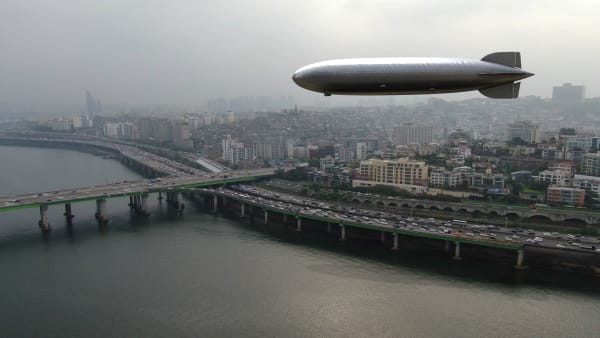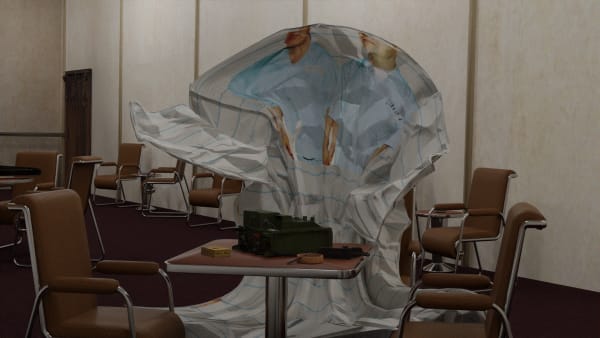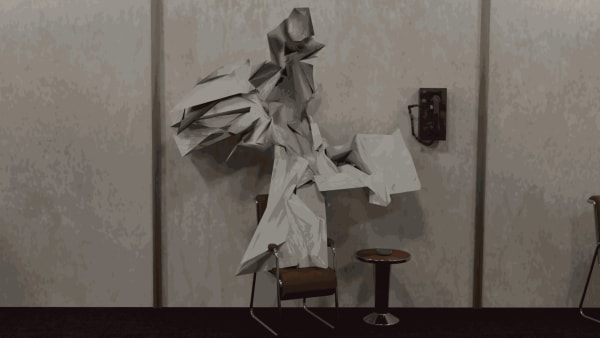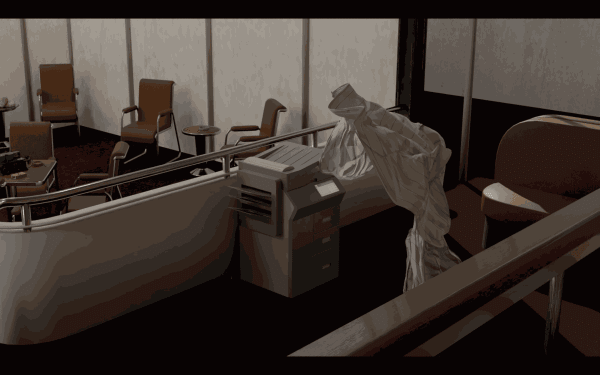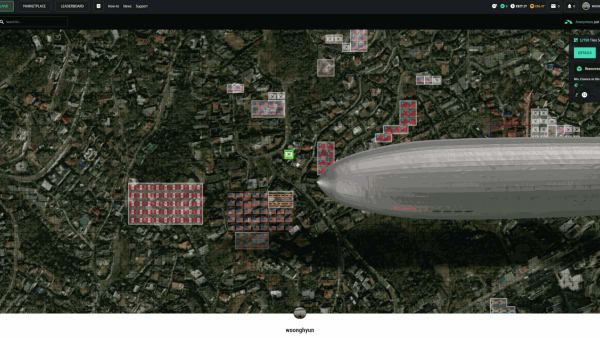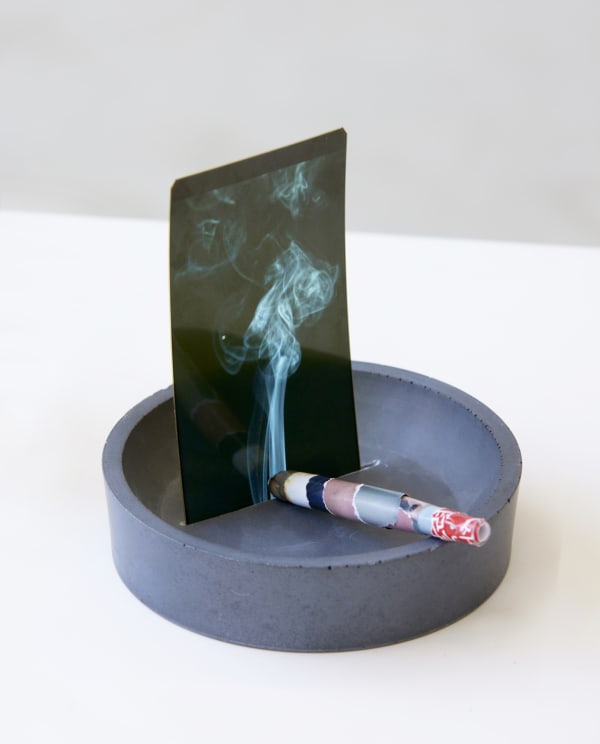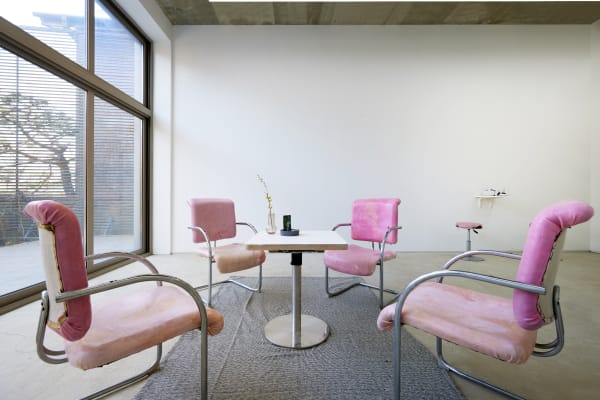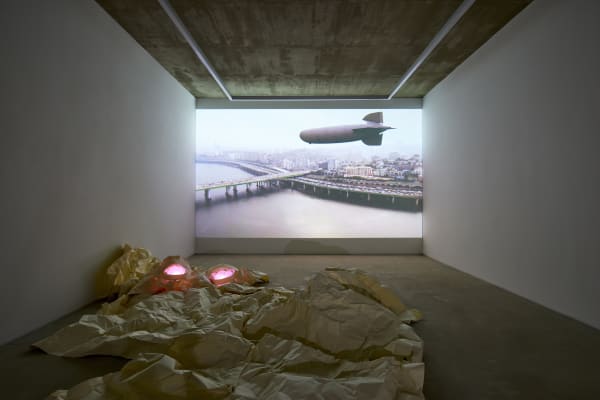Crumpled Man: 김웅현 Woonghyun Kim
김웅현 개인전 《Crumpled Man》은 한 편의 옴니버스 영화 같다. 다시 말해 독립된 짧은 이야기들을 하나의 주제 혹은 소재에 따라 엮여 놓은 형식이다. 이번 전시는 예견된 인재를 상징하는 ‘힌덴부르크 참사’, ‘수직 원근법’ 그리고 ‘시뮬레이션 사회’라는 세 개의 에피소드로 구성되어 있다. (스포일러지만) 이 모든 이야기는 결국 ‘인간’으로 점철된다. 사실 인간의 삶이 옴니버스 형식이다. 삶은 여러 에피소드가 때로는 촘촘하게 때로는 느슨하게 연결되어 있다. 멜로부터 액션, 공포, 코미디 심지어 SF까지 장르도 다양하다!
첫 번째 에피소드는 1937년에 있었던 힌덴부르크 대참사로 시작한다. 독일이 제작한 초대형 비행선인 힌덴부르크는 헬륨용으로 설계되었으나 유일한 헬륨 수출국인 미국은 비행선이 군사용으로 전용될 것을 우려하여 독일에 헬륨을 판매하지 않았다. 대신 독일은 가연성과 폭발성이 높지만 가볍고 가격이 싼 수소를 채워 힌덴부르크를 운행하게 된다. 독일은 이미 수소를 사용한 비행선이 있었고 안전 조치만 확실하다면 사고 없이 운항할 수 있다고 믿고 있었다. 실제로 운항 첫해에는 어떠한 사고도 일어나지 않았다. 그러나 독일 프랑크푸르트암마인에서 출발한 이 비행선은 1937년 5월 6일 미국 뉴저지주 레이크허스트 해군 항공기지 상공에서 수소 폭발로 화재가 발생해 전소하게 된다.
두 번째 에피소드는 근대까지의 수평적인 시선과 반대로 높은 곳에서 아래를 내려다보는 조감(鳥瞰)의 시선, 즉 ‘수직 원근법’이다. 항공술의 발달은 이 수직 원근법과 무관하지 않으며 이제 우리는 비행선 내에서뿐만 아니라 감시카메라, 위성 사진, 구글맵, 내비게이션, 게임 등 다양한 경로를 통해 수직 원근법을 경험하고 있다. 그러나 여전히 우리의 몸은 땅을 딛고 있으며 수평적 시선으로 세상을 바라보고 있다. 결국 현재 우리의 시선은 과학기술과 디지털 매체가 제공하는 수직 원근법과 몸으로부터 기인하는 수평적 원근법이 혼재되어 있다.
세 번째 에피소드는 미래를 상상하지 않는 ‘시뮬레이션 사회’다. 선행된 시행착오 즉, 시뮬레이션으로 미래의 위험성을 예측하는 현대 사회는 더 이상 미래를 상상하지 않는다. 우리는 다양한 과학 법칙을 이용하면 앞으로 일어날 상황도 예측할 수 있다고 믿는다. 미래에 대한 막연한 희망도 막연한 불안도 사라진 지금, 미래는 데이터와 그 측정값으로 서술된다. 예를 들어보자. 일기예보는 현재의 대기 상태를 수치로 보고 이를 계산해서 날씨를 예측한다. 밖의 날씨가 화창하더라도 곧 비가 올 확률이 높다고 하면 사람들은 우산을 챙겨 나간다. 혹은 비를 맞을 각오로 우산을 두고 가거나. 당연히 이를 가능하게 하는 것은 과학기술과 미디어의 발달이다.
세 개의 에피소드는 ‘구겨진 종이’로 상징되는 ‘구겨진 인간’(Crumpled Man)을 주인공으로 서울 하늘에 떠 있는 힌덴부르크 비행선에서 전개된다. <Hindenburg Lounge>는 실제로 바우하우스 스타일로 꾸며진 힌덴부르크 비행선의 라운지 모습을 3D 영상으로 재현했다. 전화기에서는 끊임없이 벨이 울린다. 예견된 인재를 알리는 전화지만 구겨진 종이는 이를 무시하고 자신이 할 말만 이어간다. 그리고 정각이 되면 구겨진 종이는 찌라시처럼 뿌려진다. 이 구겨진 종이는 예견된 인재를 당하는 사람들, 관람자(현대인)의 아바타, 예견된 인재를 알리는 리포트 등 다양한 의미를 내포하고 있다.
전시장에 설치된 <Pataphysics by F.A. Breuhaus 1, 2>의 의자 시트는 인간의 살결처럼 보인다. 김웅현은 대참사를 당한 탑승객을 직접 묘사하기보다 예측된 인재 앞에서 평온하게 비행을 즐겼을 그들을 모습을 상상하며 의자를 만들었다고 한다. <No Smoking without Fire>는 비행선 안에 흡연실이 있었다는 역사적 사실을 기반으로 한다. 폭발성이 높은 수소 비행선에 흡연실은 마치 폭탄을 안고 있는 것과 마찬가지다. 하지만 실제로 비행선 폭발의 원인은 흡연실이 아니라 급작스럽게 발생한 정전기 때문에 흘러나온 수소 가스에 불이 붙은 것으로 추측되고 있다. ‘아니 땐 굴뚝에 연기 날까’를 의미하는 이 작품명은 폭발의 원인을 역설적으로 드러낸다.
김웅현은 세 개의 에피소드를 순차적으로 보여주거나 작품별로 구별하지 않는다. 또한 어떤 에피소드를 통해서든 작업에 진입할 수 있다. 이것이 가능한 것은 각 에피소드가 원인과 결과의 관계를 갖지 않기 때문이다. 비행기와 현대의 수직적 원근법, 위험성을 알고 있음에도 비행을 감행했던 시대와 시뮬레이션으로 안전한 측정값을 선택하는 시대 등 서로 느슨한 연결성만을 가질 뿐이다. 그는 이렇게 서로 상관없는 소재들을 연결해서 가상의 시나리오를 만들고 영상과 설치를 통해 시나리오를 파편적으로 보여준다. 그의 작품은 과장, 비약 그리고 역설을 통해 각 소재들의 의미를 더욱 적나라하게 폭로한다. 그런데 놀랍게도 파편적으로 제시된 에피소드들은 인간의 주체성을 환기시킨다. 위험성을 알고도 무모하게(그리고 주체적으로) 실행했던 인간과 시뮬레이션으로 예측된 안전한 미래만을 선택하는 (혹은 선택할 수밖에 없는) 인간, 그리고 수평적 시선과 수직적 시선의 혼재로 방향을 상실한 인간. 이 총체적 난국 속에서 작가는 과장, 비약, 역설로 파놓은 함정, 그 씁쓸한 유머를 봐달라고 말한다. 역시 우리의 삶은 멜로부터 액션, 공포, 코미디 심지어 SF까지!
Artist Woonghyun Kim’s solo exhibition Crumpled Man is evocative of an anthology film that strings together related snippets of stories with a singular theme or subject matter. The three snippet-episodes of Kim’s latest solo exhibition are the predicted man-made disaster of the Hindenburg airship disaster, vertical perspective, and simulated society. The string that passes through these episodes is humanity, but in a surprisingly anthological (human-life-record) way! From melodrama to action, horror, and even science fiction!
The first episode of the Crumpled Man is the Hindenburg disaster, an airship combustion and crash that horrified the West in 1937. Partially funded by the German National Socialist German Workers' Party, the largest aircraft ever built was designed to be filled with Helium for positive buoyancy. However, Helium was only available via import from the United States, which held an air-tight monopoly on its production, but the US Congress banned its export under the Helium Act (1925), conserving helium for its own Navy airships. The Hindenburg’s engineers expected this ban to lift by the time of maiden voyage, but the ban remained and the Hindenburg was filled with hydrogen, despite its extreme flammability. Germany already owned and operated hydrogen airships and was confident the risks were manageable with adequate precautions ad safety measures. In fact, the first year of such airship operations proved to be free of incidents. However, in the second year of service on the fateful day of May 6, 1937, the Hindenburg which had departed Frankfurt au Maim in Germany was destroyed nearly instantaneously by hydrogen combustion flames during its attempt to dock with its mooring mast at the Naval Air Station at Lakehurst, New Jersey.
The second episode of the Crumpled Man concerns the vertical perspective. Unlike most perspectives leading up to Modernity, the vertical perspective is a bird’s eye view that perceives from a downturned perspective. This perspective can be explained in terms of humanity’s discovery of flight and aerial photography. This has now become so commonplace through not only surveillance camera angles, but also satellite photos, digital device-based navigation, and even digital games. Yet, our lives our lived on the ground-plane, on a horizontal surface, without our gaze parallel to the ground, mostly. That is to say, our gaze has become a blend of vertical perspectives powered by science, technology, and digital media, and horizontal perspectives rooted in our physical being.
The third episode of the Crumpled Man is simulated society. In the age where trial-and-error is simulated and obviated, future threats are also quantified and nobody imagines the future anymore. We have come to believe that with sufficient scientific method, we can predict the future. We have lost both hope and despair for the future, replaced merely by metrics and other quantified predictions. For example, if the metrological service forecasts rain, it will forecast it in a percentage chance. Those who heed that forecast – which most do – will take an umbrella with them, even if the present weather seems unlikely to turn overcast and rainy. This has been made possible by advances in science, technology, and media.
The three episodes are habituated by the Crumpled Man, in the Hindenburg airship floating over Seoul. <Hindenburg Lounge> is an actual 3D video rendering of the lounge area on the Hindenburg, based on surviving images and plans of the lounge. The phone bell rings. It is a call to notify those in the lounge that the inevitable disaster was unfolding, but the Crumpled Man ignores the voice on the other side, and merely states his business. And when the clock strikes the hour, the Crumpled Man is splayed about like brochures careless handed about at tourist traps. It signifies people who are subjected to predicted disasters, spectators’(the contemporary person’s) avatar, and the warning-report, among other things.
The seat covers of <Pataphysics by F.A. Breuhaus 1, 2> on display in the exhibition space almost looks like human skin. Woonghyun Kim made the chair himself, as indirect representations of the passengers who faced the tragedy, but before the Hindenburg was ignited that fateful morning. <No Smoking without Fire> is based on the historical fact that there was an actual smoking room on board the Hindenburg – a fact that many compare to having a live bomb onboard. Ironically, it wasn’t the sole electric-lighter guarded by one of the crew members that caused the airship to ignite, but assumed to be static electricity toward the aft of the airship that sparked and caught light on leaking hydrogen. ‘No Smoking without Fire’ is an ambiguous and paradoxical reference to also the famous epithet.
Kim does not make a clear distinguishment between the three episodes nor is chronological order necessary in his presented work; it can be approached and understood, whichever episode is first. This structure works because the episodes are not bound by cause and causation; only the loose tie-in of aircraft, modern vertical perspective, the age of flight despite (calculated) risk, and the age of choosing simulated values over actual risk and reality. The artist connects these seemingly distant or unrelated subject matter into a virtual scenario and video to create something accentuated by fragmentation, exaggeration, logic-leaping, and paradox. Unlikely yet true, these fragmented episodes remind the spectator of human agency. To understand the risks and recklessly (taking the wheel), to choose (or to have no option but to choose) a future simulated and predicted to be safe, and to completely lose our sense of direction and bearing between the grounded horizontality and the lofty verticality of perspectives. Within this chaotic pandemonium, the artist hits notes of exaggeration, logical fallacies, paradoxes, and even bitter humor, asking for the spectator’s appreciation of them. Because as we were seeking earlier, what are our lives, if not stories, and why not stories off melodrama, action, horror, and even historical science fiction?
